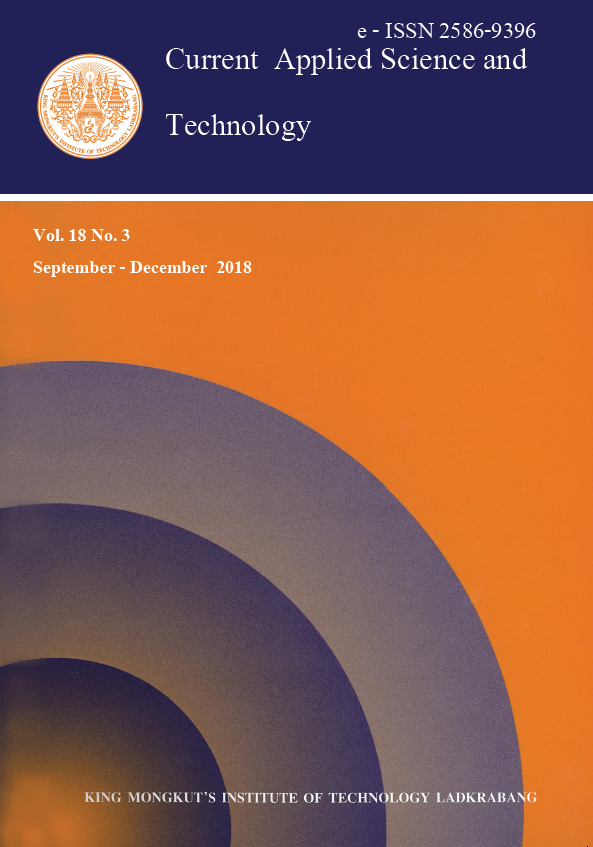Botanical Characteristics and Pectin Properties of Canthium parvifolium Roxb.
Main Article Content
Abstract
Canthium parvifolium Roxb. is a native plant found in the northern region of Thailand. Canthium parvifolium Roxb. has been found to have pectin in the fruits. Accordingly, the botanical characteristics of C. parvifolium and characterization of its pectin were evaluated. It was found that the habit of this plant is shrub with paired straight supra axillary thorns. Leaves are simple and opposite in arrangement with interpetiolar stipule. Young branches and lower surface of leaves are covered with pubescence. The inflorescence is axillary cymose. Calyx is green and limb is very short undulating 5-lobed with subglobse ovary portion. Corolla is tubular with 5 lobes, green to white or yellow in color. There are 5 stamens inserted at corolla throat. The ovary is inferior, 2-loculate with only 1 ovule each. The edible fruits are ovoid in shape and the skin is green or yellow, depending on maturity. The fruits of C. parvifolium were used as plant materials for pectin properties. The extracted pectin was designated as pectin with high degree of esterification due to its low moisture of 10.00% and the approximately 76.92% degree of esterification (DE) with methoxyl content around 7.06%. In addition, C. parvifolium yielded pectin around 38.00%. The chemical structure of pectin was studied through Fourier Transform Infrared (FTIR) spectroscopy and 1H NMR spectroscopy. On the other hand, the molecular vibration was confirmed by using Density Functional Theory (DFT).
Keywords: Canthium parvifolium, botanical characteristics, pectin, density functional theory
*Corresponding author: Tel.: 05-377-6011 Fax: 05-377-6012
E-mail: em_waleepan_r@crru.ac.th
Article Details
Copyright Transfer Statement
The copyright of this article is transferred to Current Applied Science and Technology journal with effect if and when the article is accepted for publication. The copyright transfer covers the exclusive right to reproduce and distribute the article, including reprints, translations, photographic reproductions, electronic form (offline, online) or any other reproductions of similar nature.
The author warrants that this contribution is original and that he/she has full power to make this grant. The author signs for and accepts responsibility for releasing this material on behalf of any and all co-authors.
Here is the link for download: Copyright transfer form.pdf
References
[2] Chase, W.M., 2009. An update of the Angiosperm Phylogeny Group classification for the orders and families of flowering plants: APG III. Botanical Journal of the Linnean Society, 161, 105–121.
[3] Kaewpo, W., 2005. The extraction of pectin from local plant at Ban Thungkho, Wiangchiangrung district, Chiang Rai province. Special Problem. Faculty of Science and Technology, Chiang Rai Rajabhat University, Chiang Rai, Thailand.
[4] Rathinavelu, R. and Graziosi, G., 2005. Use of coffee wastes and by-products: A summary. International Coffee Organization, 1967/ 05, 1-2.
[5] Saha, D. and Bhattacharya, S., 2010. Hydrocolloids as thickening and gelling agents in food: a critical review. Journal of Food Science and Technology, 47, 587–597.
[6] Oakenfull, D. and Scott, A., 1984. Hydrophobic interaction in the gelation of high methoxyl pectins. Journal of Food Science and Technology, 49, 1098.
[7] Voragen, A.G.J., Pilnik, W., Thibault, J.F., Axelos, M.A.V. and Renar, C.M.G.C., 1995. Pectins. In A.M. Stephan (Ed.) Food Polysaccharides and their Applications, New York: Marcel Dekker, Inc., 287–339.
[8] Sila, D., van Buggenhout, S., Duvetter, T., Fraeye, I., de Roeck, A., van Loey, A., Hendrickx, M., 2009. Pectins in processed fruits and vegetables. Part II − Structure-function relationships. Comprehensive Reviews in Food Science and Food Safety, 8, 86−104.
[9] Cheng, H.N., and Neiss, T.G., 2012. Solution NMR spectroscopy of food polysaccharides. Polymer Reviews, 52, 81−114.
[10] Simmler, C., Napolitano, J.G., McAlpine, J.B., Chen, S.N., and Pauli, G.F., 2014. Universal quantitative NMR analysis of complex natural samples. Current Opinion in Biotechnology, 25, 51−59.
[11] Cramer, C. J., 2004. Essentials Computational Chemistry, Wiley: Hoboken, NJ.
[12] Monfregola, L., Bugatti, V., Amodeo, P., Luca, S.D. and Vittoria, V., 2011. Physical and water sorption properties of chemically modifies pectin with and environmentally friendly process. Biomacromolecules, 12, 2311–2318.
[13] Chaiwong, C., Tunma, S., Sangprasert, W., Nimmanpipug, P. and Boonyawan, D., 2010. Graft polymerization of flame-retardant compound onto silk via plasma jet. Surface and Coatings Technology, 204, 2991–2995.
[14] AOAC (1998) Official Methods of Analysis. 16th Edition, Association of Official Analytical Chemists, Arlington.
[15] Accelrys Materials Studio (Version v 5.5), 2007. Accelrys Inc., San Diego, USA.
[16] Joshi, V.K. and Attri, D., 2006. Solid state fermentation of apple pomace for the production of value added product. Natural Product Radiance, 5(4), 289-296.
[17] JECFA (Compendium of food additive specifications Addendum 9). 2001. The Joint FAO/WHO Expert Commitee on Food Additives 57th , Rome, Italy, 75 – 79.
[18] Ptichkina, N.M., Markina, O.A. and Rumyantseva, G.N., 2008. Pectin extraction from pumpkin with the aid of microbial enzymes. Food Hydrocolloid, 22, 192–195.
[19] Pagan, J., Ibarz, A., Llorca, M. and Coll, L., 1999. Quality of industrial pectin extracted from peach pomace at different pH and temperatures. Journal of the Science of Food and Agriculture, 79, 1038–1042.
[20] Daas, P.J.H., Boxma, B., Hopman, A.M.C.P., Voragen, A.G.J. and Schols, H.A., 2001. Nonesterified galacturonic acid sequence homology of pectins. Biopolymers, 58, 1-8.
[21] Rouse, A.H., 1977. Pectin: distribution, significance. Dalam Nagy S.P., Shaw E., Veldhuis M.K. (eds). Citrus Science and Technology (1). The AVI Publishing Company Inc.
[22] Rangana, S., 1986. Handbook of analysis and quality control for fruits and vegetables products, Tata McGraw-Hill Publishing Company Limited, New Delhi.
[23] Sungpud, C., Sungpud, J. and Phasuk, N., 2005. Chemical and physical properties of pectin powder from pummelo fruit. Master Thesis. Chiang Mai University, Thailand.


